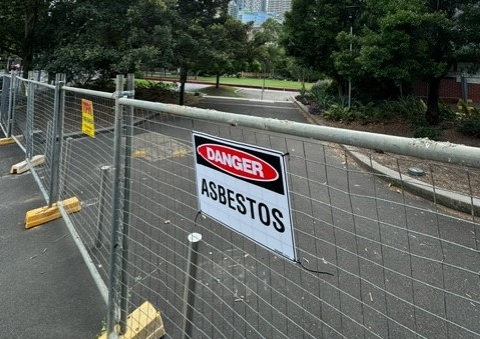
Glebe Island dust-up
by ALEC SMART
The proposed construction of a facility for the delivery, storage and distribution of construction materials, including sand and concrete, on the east side of Glebe Island in Sydney Harbour, faces strong community opposition.
On Monday 28 October, the Port Authority of NSW granted approval to its own plan for a ‘multi user facility’ reactivating the currently-disused former car import site beneath Anzac Bridge. Located on the western shore of Jones Bay opposite Pyrmont, over 200 submissions were made to the authority, including concerns about air quality, noise levels and traffic congestion.
In a statement the Port Authority said: “Dry bulk construction materials will be offloaded from ships via their unloading equipment and into the facility, where the materials can then be loaded from the storage bays onto trucks within the building.”
Residents of neighbouring communities have been told the new storage facilities will be 210 metres long, 65 metres wide and five storeys high. The construction materials will include millions of tonnes of cement, aggregate, sand and associated materials destined for the NSW Government’s multiple infrastructure projects.
30 years of noise and dust
According to the Port Authority of NSW’s January 2018 release, Glebe Island: the Gateway to Sydney’s Future: “the port at Glebe Island is at the centre of the Bays Precinct Urban Transformation Program, an ambitious urban renewal plan to reinvent and revitalise a central area of Sydney Harbour and transform it into a hub of commercial, residential and recreational innovation.
“This long-term project, along with 70 billion dollars’ worth of other major works like WestConnex, will require immense amounts of construction materials such as cement, sand and aggregate for the concrete supply chain…
“Independent modelling has forecast that annual construction material throughput at Glebe Island would be between six and eight million tonnes within the next 30 years.”
In a strategic review, Infrastructure NSW (an independent statutory agency that assists the NSW Government) recommended retaining and expanding the port facilities on Glebe Island, to meet the supply needs of the construction industry.
In their 2017 Annual Report they stated: “The review also examined how the … proposal could best integrate with Sydney Metro West and other key infrastructure projects… Given the importance of the construction industry to the state’s economy … the review concluded that Glebe Island should continue to import bulk materials used for the production of concrete for at least the next 20 years… The NSW Government endorsed the review findings and recommendations in full.”
The NSW Government affirm: “Glebe Island is identified in the Transformation Plan: The Bays Precinct Sydney as a long-term priority with works commencing in 2022 and beyond.”
Infrastructure NSW, under its specialist unit Projects NSW, is currently responsible for overseeing multiple government-accredited projects, several mired in controversy, including Barangaroo, Blackwattle Bay, Sydney Football Stadium redevelopment and the Waterloo Housing Estate, as well as the construction of Australia’s largest prison for 1700 prisoners near Grafton.
Loads of truckloads
The Port Authority claim that bringing crushed rock, sand and gravel in by ship to the proposed Glebe Island facility will have less impact on Sydneysiders than utilising fleets of trucks. “A single vessel can replace between 1100 – 1500 truckloads of material,” they state in their Oct 28 approval summary.
Nevertheless, hundreds of daily truck movements will still be needed to transport materials from Glebe Island to major construction projects over the next decade or more, including the neighbouring WestConnex interchange toll road; the Sydney Metro harbour rail tunnel between Millers Point and McMahons Point; and the Western Harbour Tunnel between Rozelle and Balgowlah.
Hanson Heidelburg Cement Group, currently operating beside the Fish Markets in Blackwattle Bay, have also submitted a development application to relocate to Glebe Island and construct an enormous concrete batching plant. This factory will sit alongside the Port Authority of NSW’s multi-user buildings for storage and processing.
Surrounding properties have reportedly depreciated significantly since the proposal was announced in 2018, some by as much as half a million dollars. Residents who purchased homes in Pyrmont on the opposite shore, many of them prime waterfront high-rise apartments within 200 metres of the 24-hour, 7-day-a-week operational Glebe Island terminal, are expressing outrage at the approval.
Betrayal
Pyrmont, Sydney’s most densely-populated suburb with over 22,500 residents, was repurposed at the start of the millennium from abandoned factories, old terraces and industry. 24 hectares were developed into residential townhouses and apartments alongside landscaped parks and gardens with children’s play areas, barbecues, and seafront walks. Much of it was concentrated around Jackson’s Landing, the 11-hectare site of a former sugar refinery, and includes community facilities such as gyms, tennis courts, a community centre and a swimming pool.
Many new Pyrmont residents see the Glebe Island facility as a betrayal by the NSW Government, furious they were lured into a family-friendly zone at great personal expense, believing it would remain an ideal area in which to raise children and socialise.
They now have to contend with a future of continuous industrial noise and an atmosphere of swirling dust and concrete powder.
The Don’t Waste Glebe Island campaign (DWGI), launched in March 2018 by residents from Jacksons Landing and surrounds, strongly opposes the Port Authority’s proposal.
On their website they state: “Glebe Island should be a hub for Sydneysiders and tourists alike, with stunning waterfront destinations, open public and green spaces, community hubs, recreation and cultural facilities and more.
“Sydney deserves Glebe Island to become an iconic waterfront destination like the world-class Opera House and Barangaroo sites, as was promised by the NSW Government.”
Councillor Pauline Lockie of the Inner West Council is angry about the Port Authority’s decision and is taking up residents’ concerns. She told City Hub: “The Port Authority’s approval is concerning for a number of reasons. Inner West Council has already raised concerns about the noise, air quality and traffic issues the new facility is likely to have on residents, especially given the amount of construction that’s planned in the area.
WestConnex, the Western Harbour Tunnel, and the Sydney Metro West all have major construction works in the local area, and the NSW government has never assessed the cumulative impacts of all these works on residents. But as we’re already seeing elsewhere in the inner west, having multiple projects in one place has serious impacts on people’s lives.
The fact that the same authority can propose, assess and approve its own project also makes a mockery of the planning process.”
Balmain MP Jamie Parker agreed that allowing the Port Authority to approve its own development application “makes a mockery of the notion of independent planning approval.”
================
History of Glebe Island
Glebe Island, once a 12 hectare island covered in trees and accessible from Balmain at low tide, was granted to chaplain Reverend Richard Johnson of the First Fleet as church property.
In 1842, after a stone causeway was laid, it was sub-divided and sold, although plans for four streets and 86 lots were never followed though. From 1852 a stock yard and abattoirs were constructed and three decades later they featured prominently in the 1882 Royal Commission into noxious and offensive trades, instigated by complaints from Balmain and Glebe Point residents.
In 1862 a low timber bridge was built connecting the island to Pyrmont and the city but from the 1890s the process of connecting it to the mainland on the Rozelle side began, reinforced from 1915 with ballast from Pyrmont Quarry.
In 1912 the abattoirs relocated to Homebush, whereupon three wharves were constructed along the Rozelle Bay, Jones Bay and White Bay anchorages and it was levelled to become the site of a grain elevator and concrete silos.
During World War II Glebe Island was commandeered by the United States Army for their main Sydney depot, but reverted to wheat storage until 1990, when the wheat terminal was transferred to Port Kembla and some of the silos, now heritage-listed, were repurposed for cement storage.
Thereafter Glebe island was used as an unloading and storage facility for imported vehicles until it was closed in November 2008.









